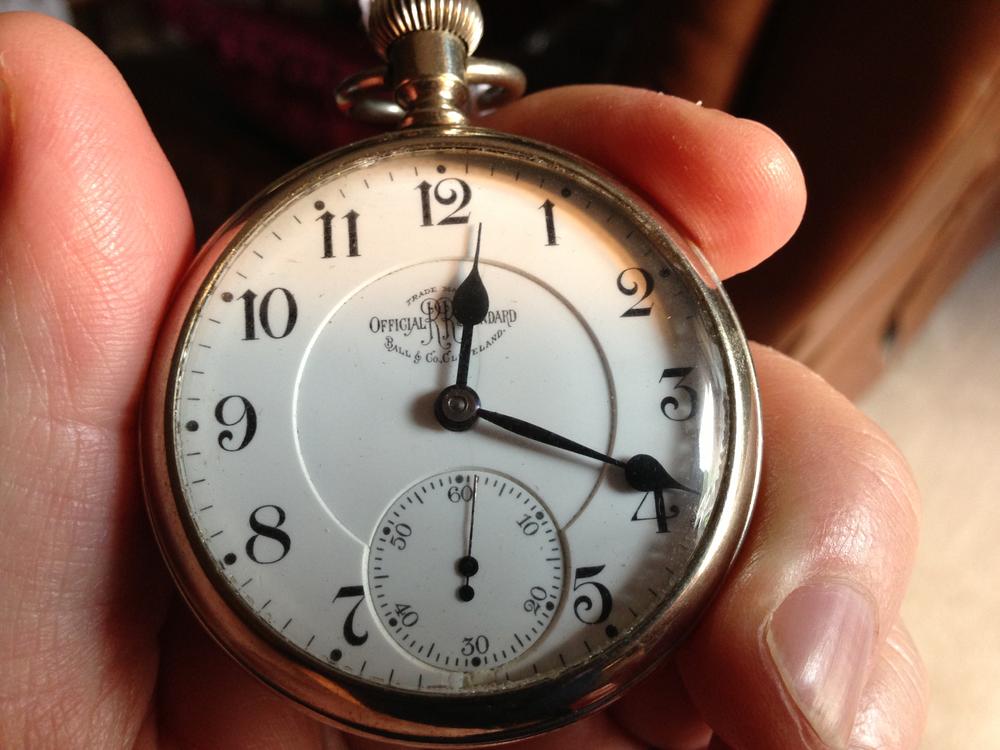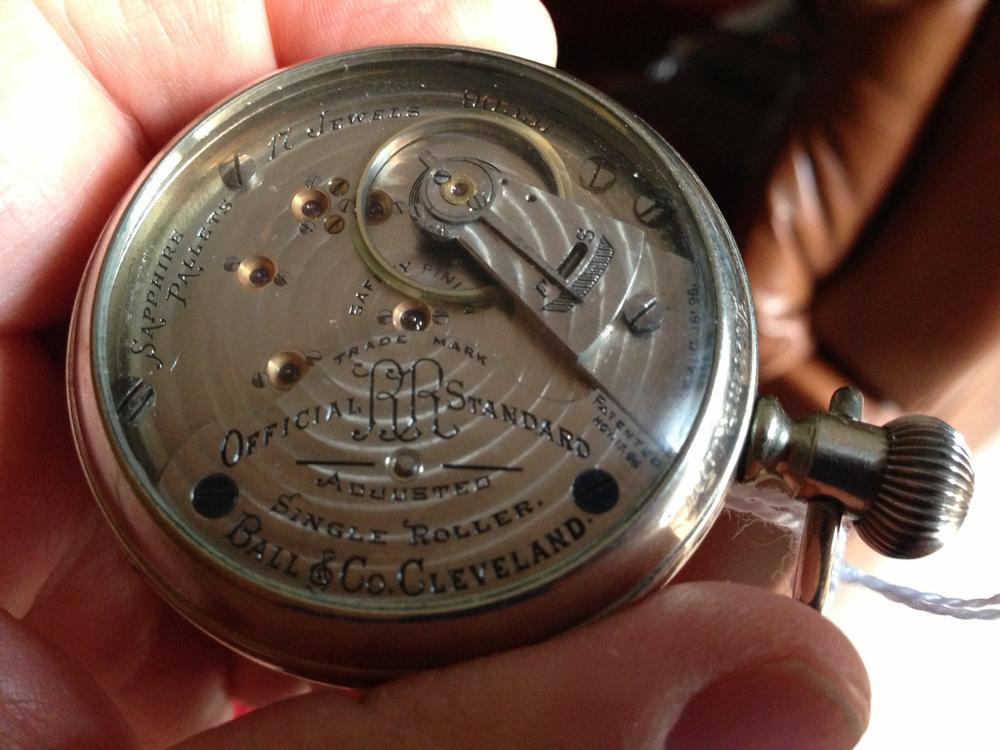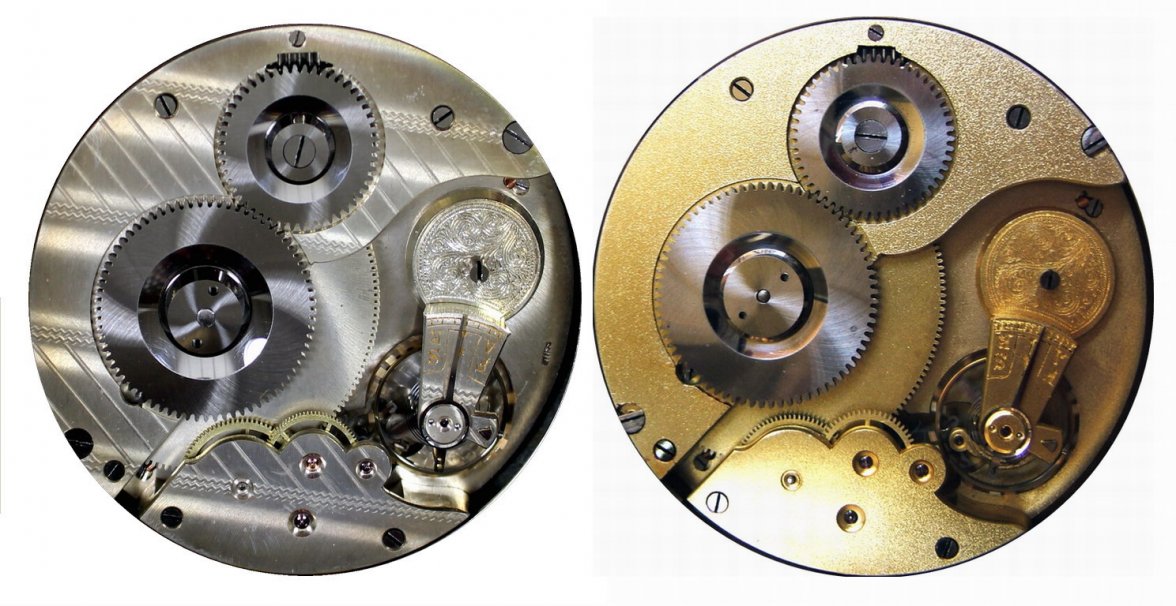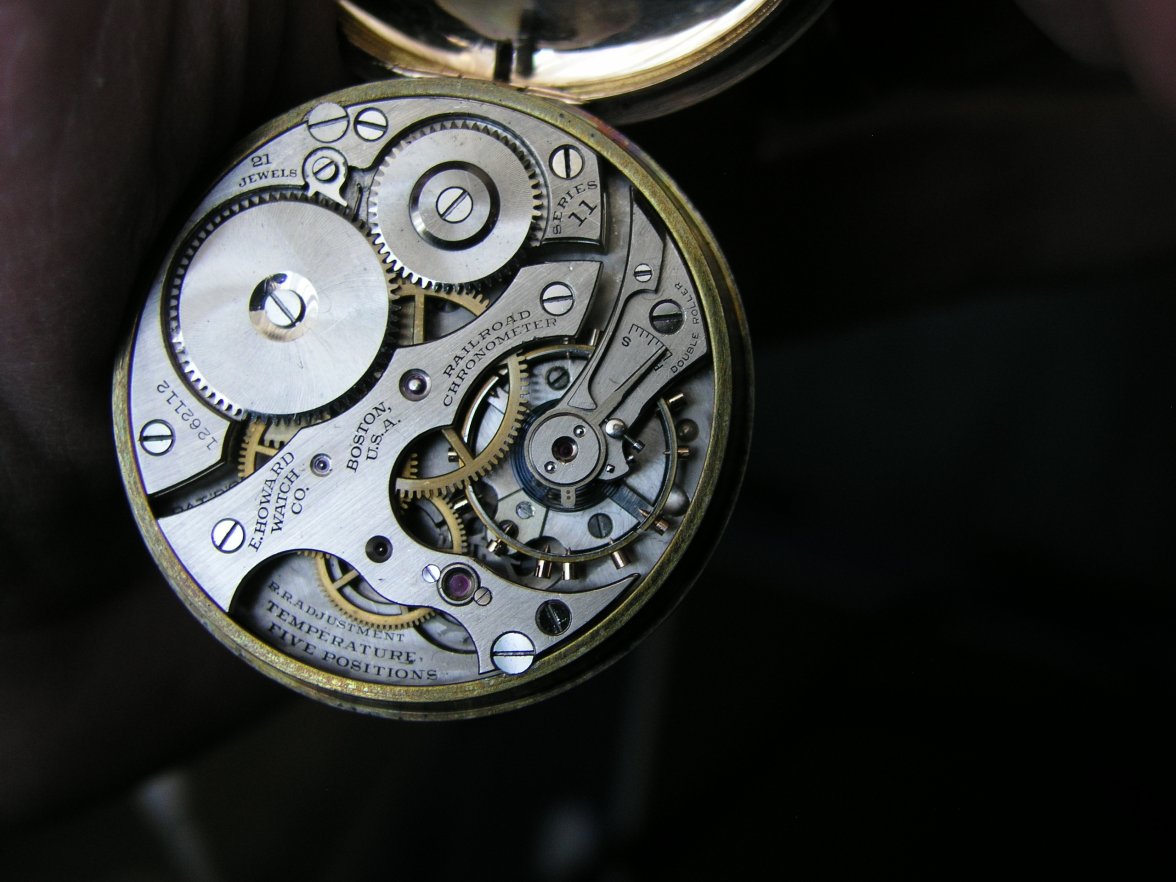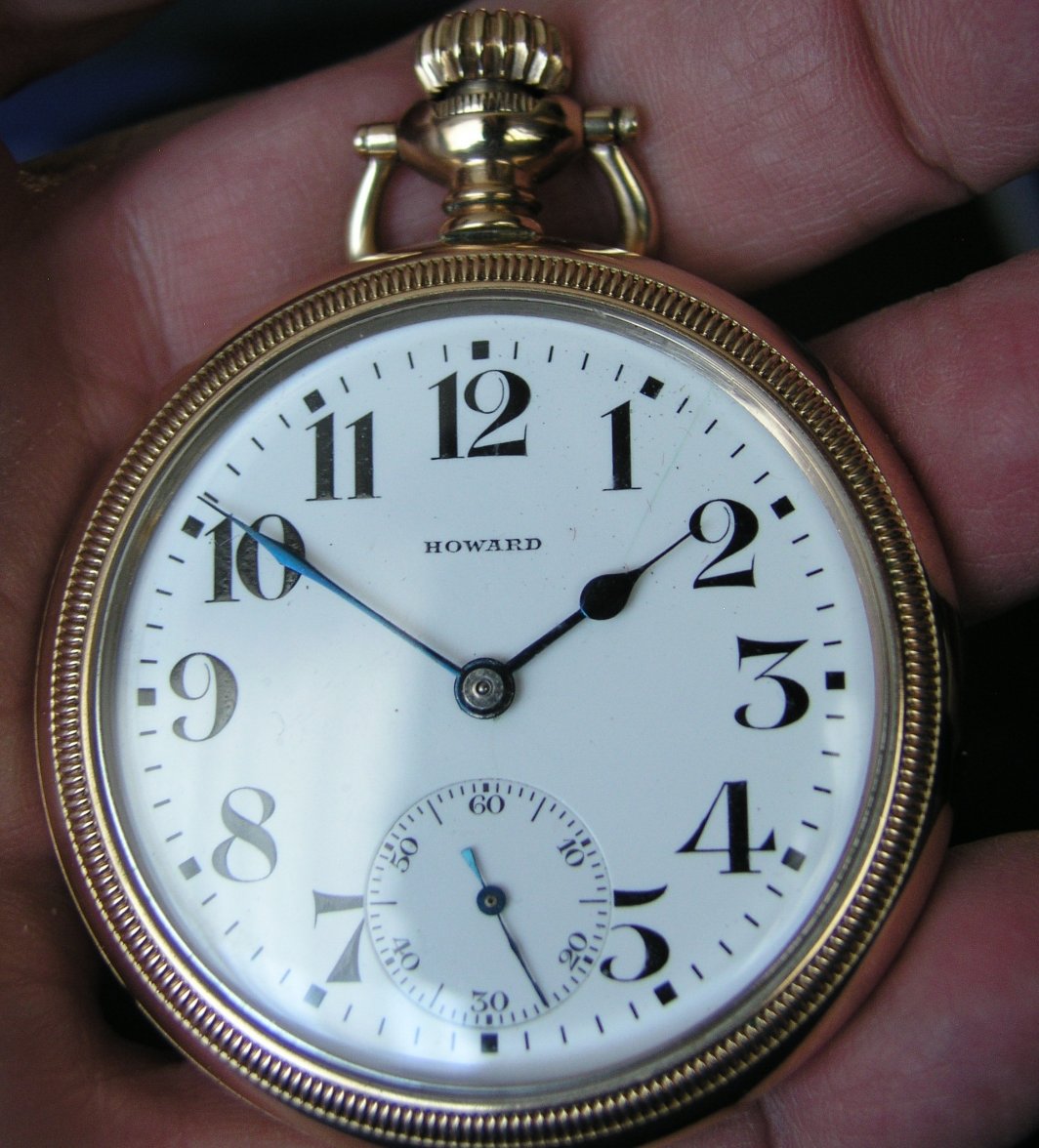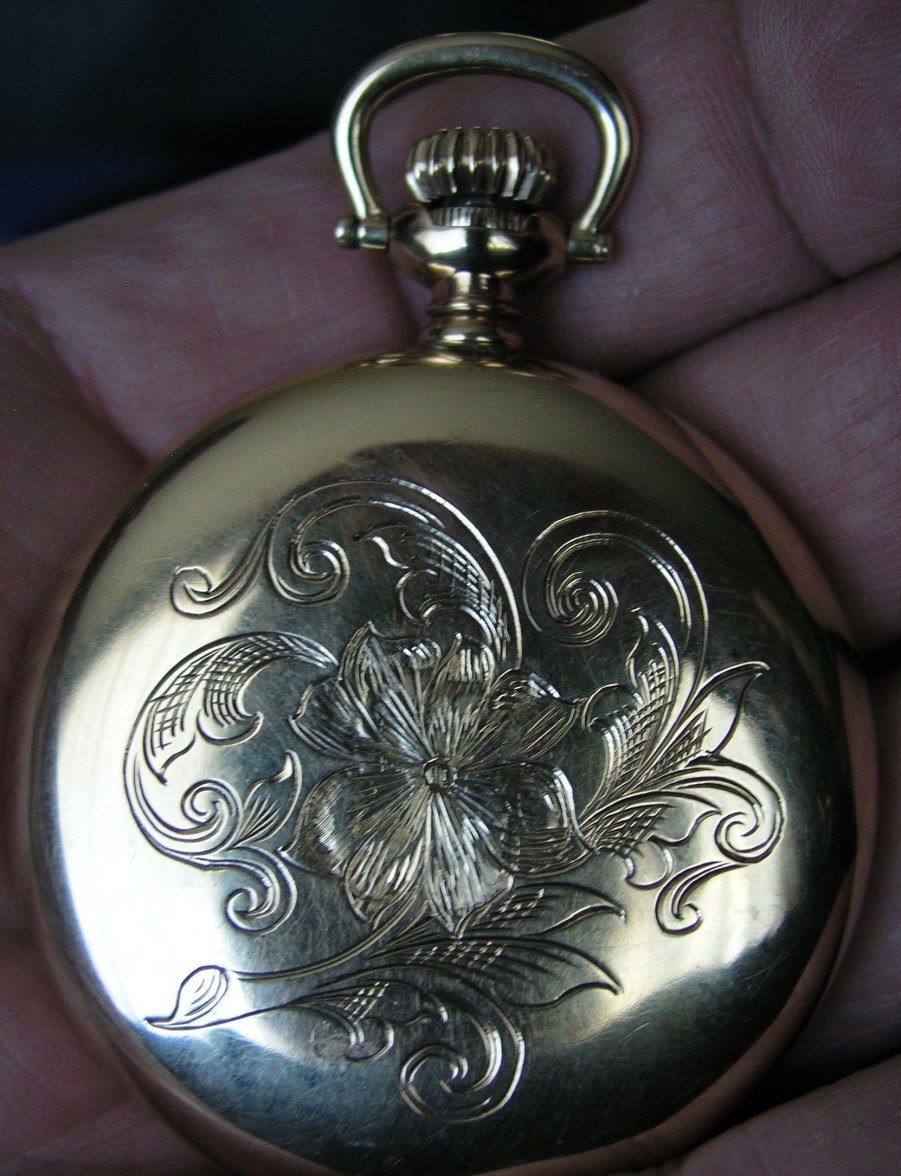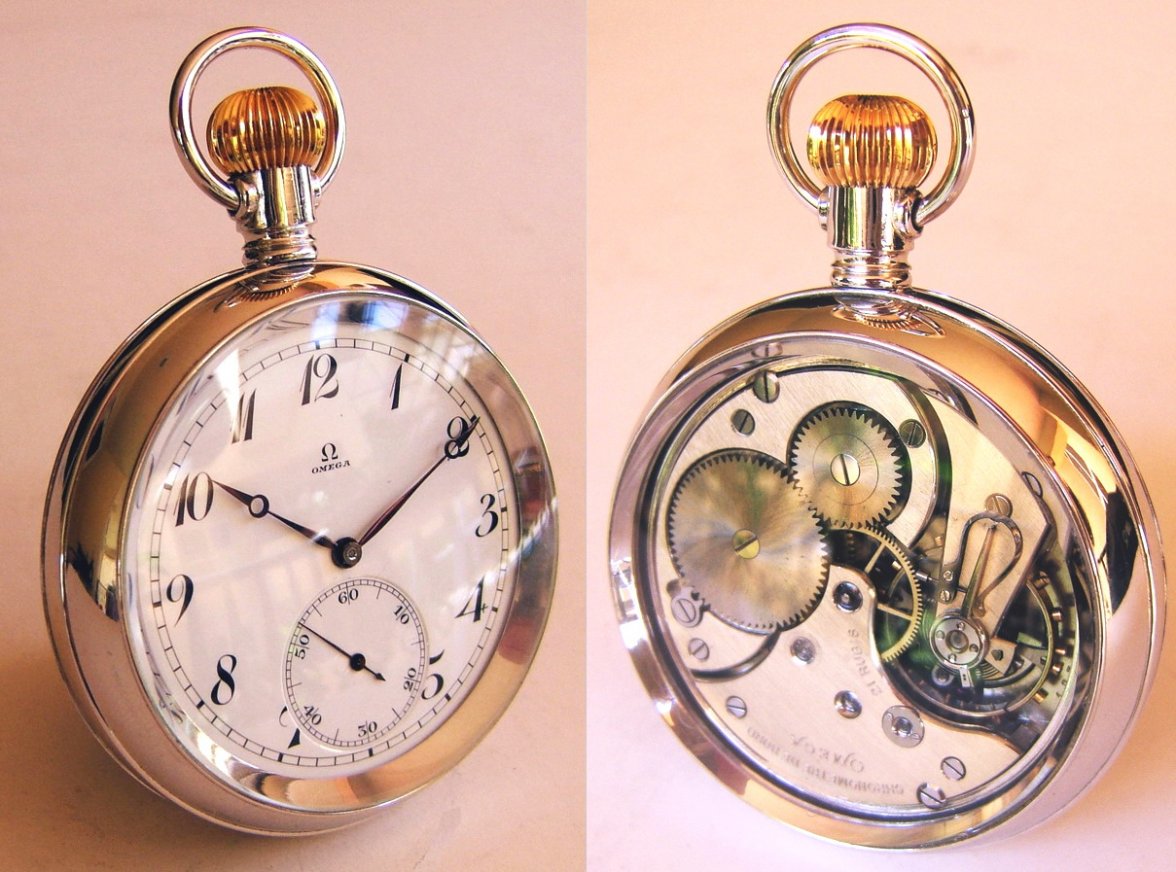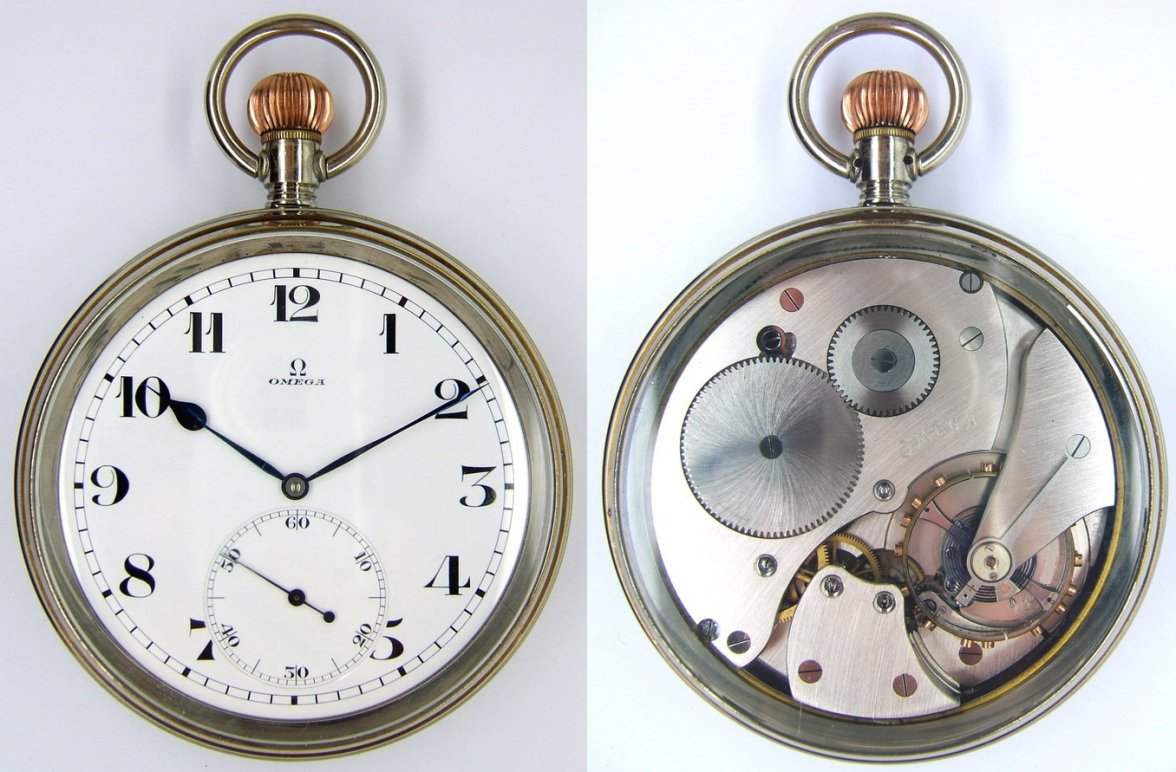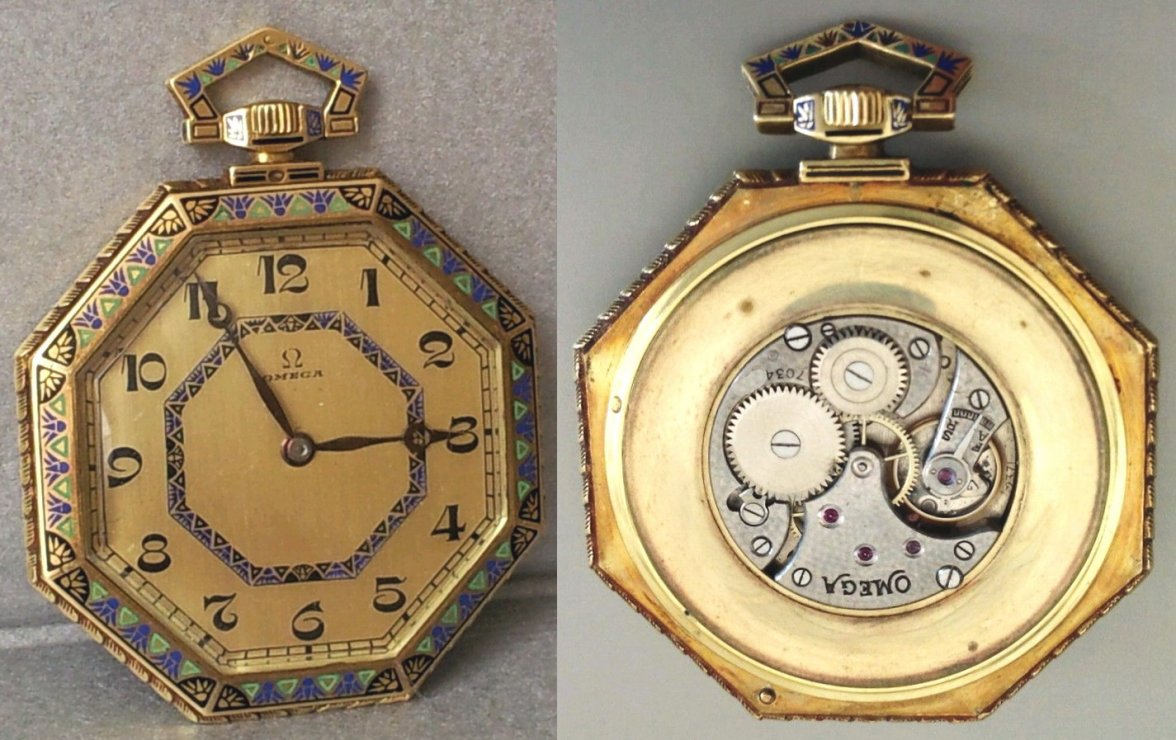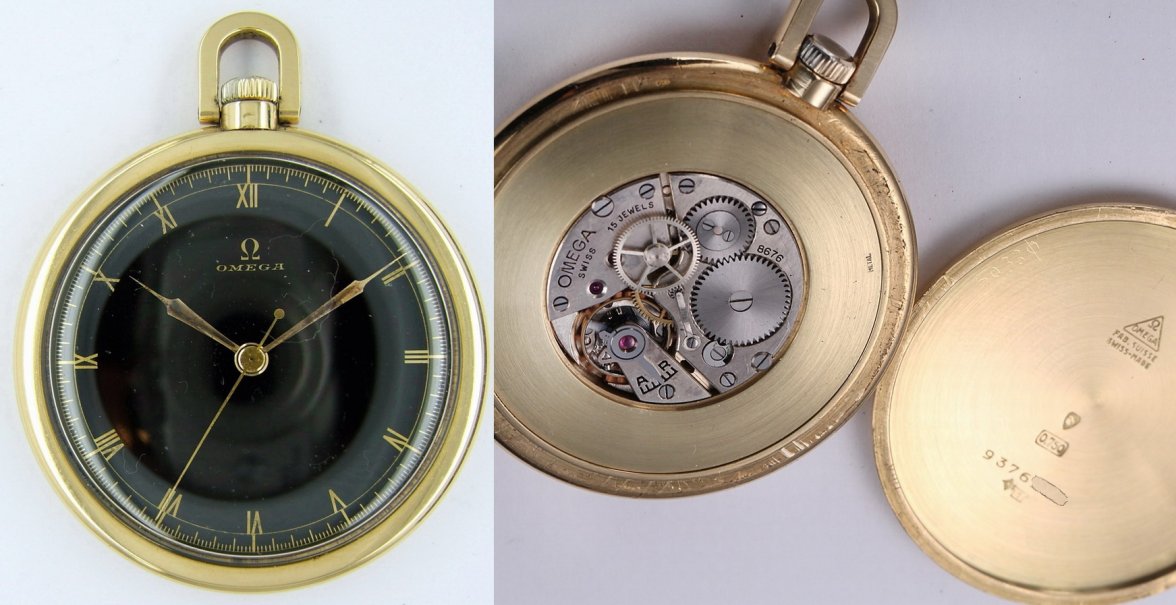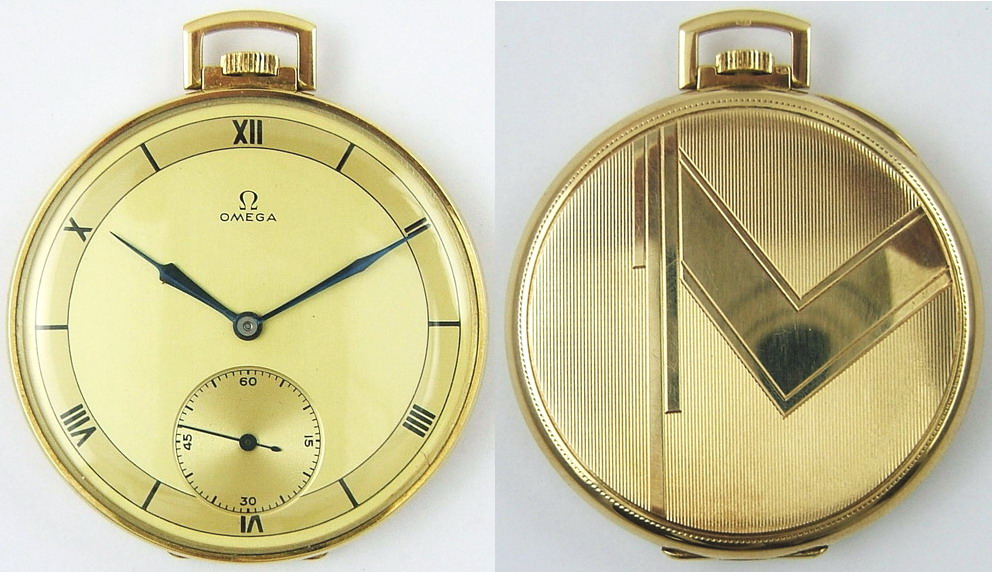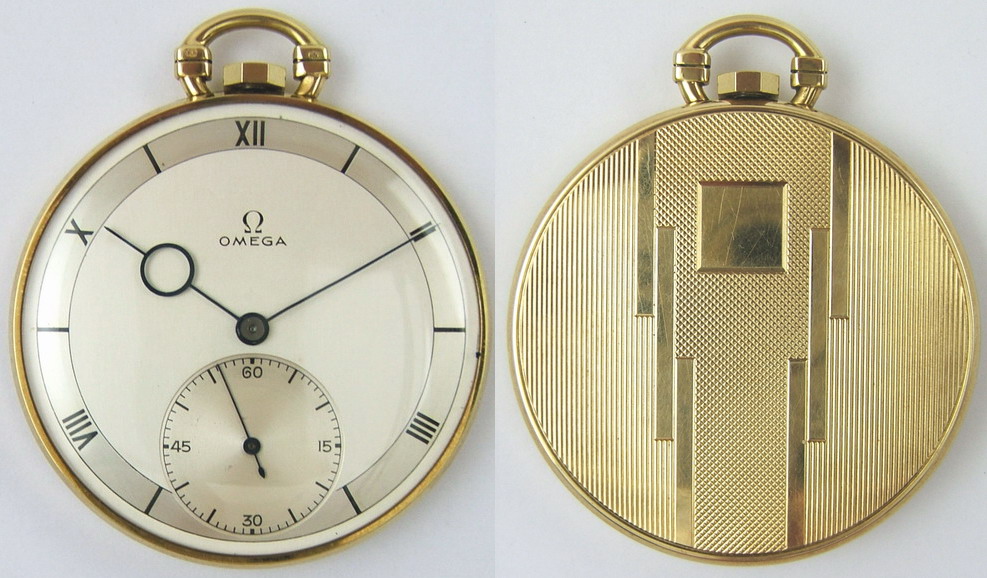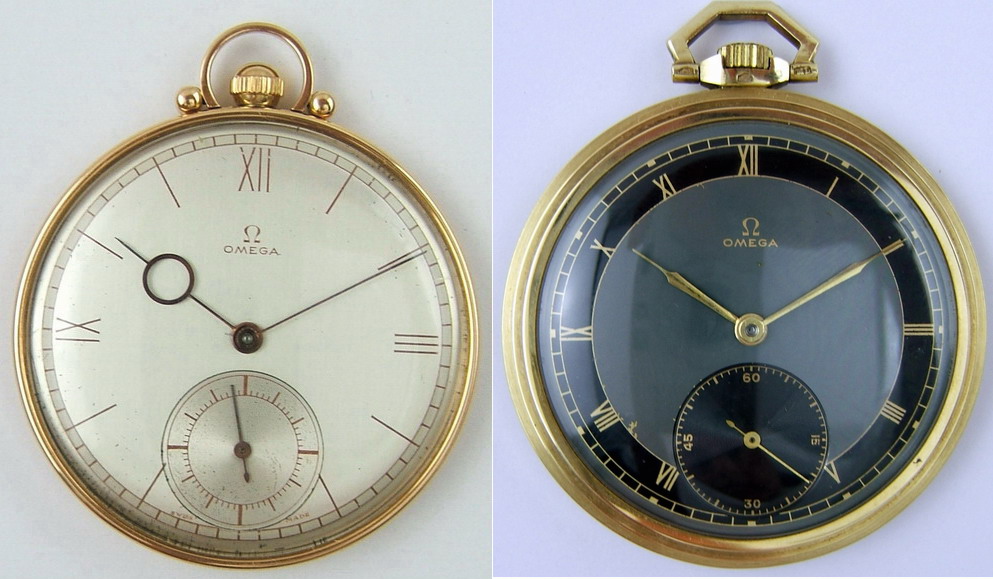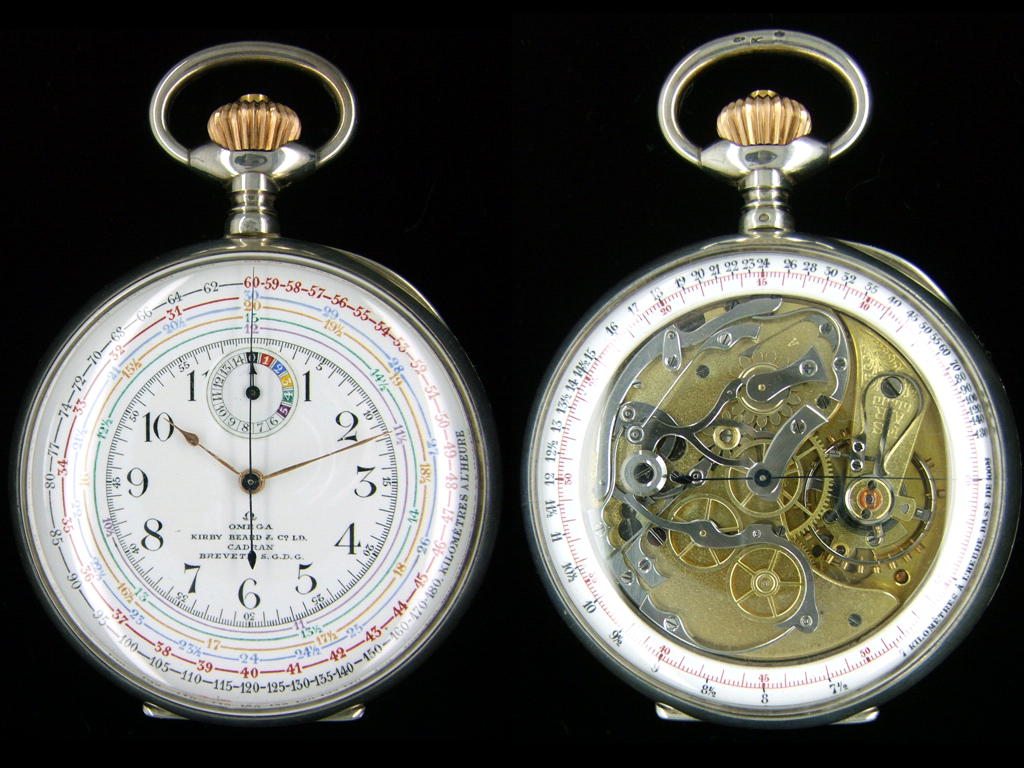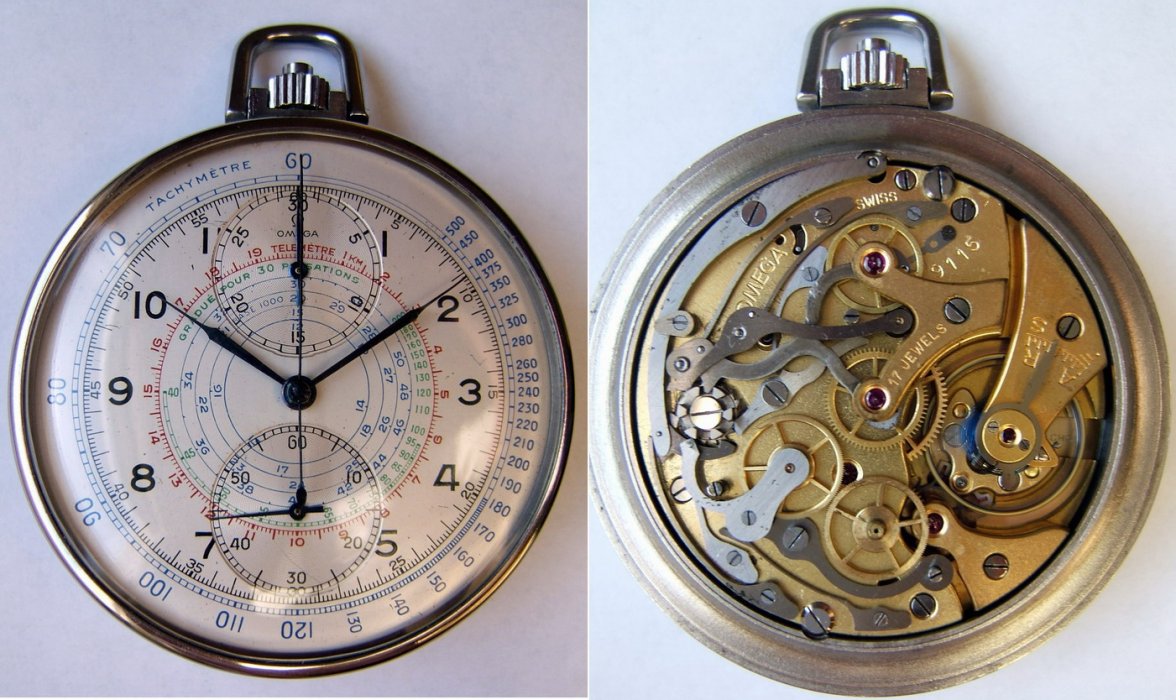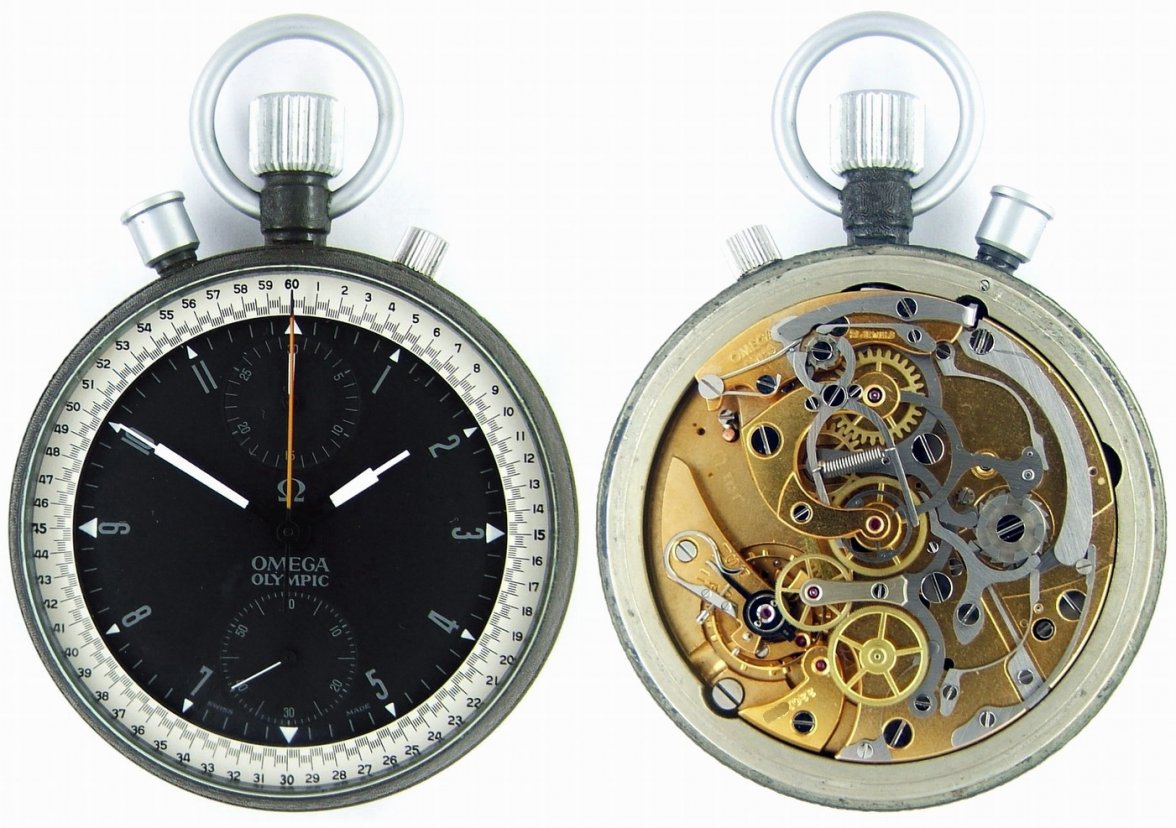"Pocket watches"... out with 'em! Come on, lets see them!
Canuck
·Ball, 18-size, made for Ball by the Hamilton Watch Co. From the browsing I have done, the set up on the 18-size Ball Hamilton regulator is different to many (all?) 18-size Hamilton models. It appears as though you also are either missing the vernier screw that moves the regulator, or the head might be broken off the screw. In your search for parts, it might be helpful if you searched.for Ball/Hamilton parts.
murph
·Hi you all, Looking back a 100-150 years, how do the American pockets and the Swiss stack up. With accuracy so desired, I can imagine these companies were eyeing each others work. The few pictures I've seen show fancy American metal work but which kept better time? An American Co. a Swiss Co. (Go Team OMEGA), or the...?
OMTOM
·The few pictures I've seen show fancy American metal work
But to refer only to your point about the ‘decoration’ of US movements, Omega pocket watches that were exported to the US (certainly around the period 1900) had decorated movements and were silvered (‘argenté’), while the same calibres for other markets were plain, gilded.
The following shows Omega ‘Goliath’ 30’’’ movements, on the left for the US market, on the right sent to UK.
Canuck
·Hi you all, Looking back a 100-150 years, how do the American pockets and the Swiss stack up. With accuracy so desired, I can imagine these companies were eyeing each others work. The few pictures I've seen show fancy American metal work but which kept better time? An American Co. a Swiss Co. (Go Team OMEGA), or the...?
There may be other answers on this, but here’s how I see it. In the 19th century, the Swiss made a lot of watches, but mostly for domestic use. They were largely produced by the craft method, with specialists each producing a limited range of parts. These components were then assembled into finished watches by “finishers”. The Swiss were able to produce some very fine watches, but when they developed aspirations to take their product world wide, their production methods generally meant they could not produce good watches consistently, in quantity sufficient to build market share elsewhere in the world. At this time, American watchmakers had learned how to built the machinery that could fabricate consistent quality parts, enabling them to produce good watches for an expanding market, and the consistency of their parts fabrication enabled them to supply spare parts which consistently fitted. The Swiss took lessons from American makers, and American ideas (and possibly machinery) back to Switzerland, and very soon, the Swiss expanded their production to become a world power with machine made watches, rather than watches produced by the craft method. The best Swiss watches competed very well with the best American watches, but the decoration on some American watches is unrivalled IMO. Generally, American railroad watches were preferred in the US, but while Canada also gave priority to American railroad watches, Canadian railroads also accepted Swiss made, high grade watches for railroad use. i. e. Longines, Zenith, Brandt, Omega. Elaborate decoration on American movements may have had something to do with how retailers sold watches. Until the American makers commenced selling their watches, cased, in the store, a watch buyer would see uncased movements, and would choose a case, dial, and possibly hands, and the watch would be set up at the store. He would have to pay a lot more for highly precise timekeepers, so the best watches were adorned with “eye candy” to help justify the higher price. I have two Swiss railroad watches in my collection which perform as well as my best American ones. But they simply don’t compete in the decoration department. That’s how I see it.
murph
·There may be other answers on this, but here’s how I see it. In the 19th century, the Swiss made a lot of watches, but mostly for domestic use. They were largely produced by the craft method, with specialists each producing a limited range of parts. These components were then assembled into finished watches by “finishers”. The Swiss were able to produce some very fine watches, but when they developed aspirations to take their product world wide, their production methods generally meant they could not produce good watches consistently, in quantity sufficient to build market share elsewhere in the world. At this time, American watchmakers had learned how to built the machinery that could fabricate consistent quality parts, enabling them to produce good watches for an expanding market, and the consistency of their parts fabrication enabled them to supply spare parts which consistently fitted. The Swiss took lessons from American makers, and American ideas (and possibly machinery) back to Switzerland, and very soon, the Swiss expanded their production to become a world power with machine made watches, rather than watches produced by the craft method. The best Swiss watches competed very well with the best American watches, but the decoration on some American watches is unrivalled IMO. Generally, American railroad watches were preferred in the US, but while Canada also gave priority to American railroad watches, Canadian railroads also accepted Swiss made, high grade watches for railroad use. i. e. Longines, Zenith, Brandt, Omega. Elaborate decoration on American movements may have had something to do with how retailers sold watches. Until the American makers commenced selling their watches, cased, in the store, a watch buyer would see uncased movements, and would choose a case, dial, and possibly hands, and the watch would be set up at the store. He would have to pay a lot more for highly precise timekeepers, so the best watches were adorned with “eye candy” to help justify the higher price. I have two Swiss railroad watches in my collection which perform as well as my best American ones. But they simply don’t compete in the decoration department. That’s how I see it.
Waltesefalcon
·I think that American watch companies were much more forward thinking than their Swiss counterparts. I can't speak for high end Swiss watches but I have owned many Swiss pocket watches made in the late nineteenth century and they almost all had cylinder escapments. Even my really cheap seven jewel Elgins have all had lever escapements. I have the feeling that it wasn't until the 1890s through WWI that the Swiss started to catch up to American technology in watch making.
Edited:
Canuck
·The American watch companies took a page from armaments manufacturers who, early on, learned to produce guns from exact duplicate machine made parts. On the battlefield, gunsmiths weren’t required to repair guns. A stock of factory made repair parts were all that was required. American watchmakers learned from that. It was after about 1850 that the true “factory” watch began to be produced in America. But it still took the American watch manufacturers a few years to really refine the process.
This video produced by the Illinois Watch Co. from about 1920 will help you understand what is meant by a “factory” made watch.
This video produced by the Illinois Watch Co. from about 1920 will help you understand what is meant by a “factory” made watch.
OMTOM
·@Waltesefalcon @Canuck
This is surely the significance of the Omega story - from 1894. Until then, everything that you write is true. The Louis Brandt organisation changed the Swiss story from then on. @Waltesefalcon, Omega did not produce any calibres with cylinder escapements - although the factory did continue to produce earlier ‘sister brands’, and that included some old calibres that you are quoting.
What Henry Ford did for the US motor industry (in 1908?), the Louis Brandt organisation started for the Swiss watch industry in 1894.
One can look at the rule of the British watch-making industry in earlier years, followed by the American industry (as you have described), followed (from 1894) by the Swiss industry. So a reasonable question would be to define the qualities that allowed the Swiss to take over - thoroughness, attention to detail, quality? I don’t know - but they did!
Excellent video Canuck, thank you.
This is surely the significance of the Omega story - from 1894. Until then, everything that you write is true. The Louis Brandt organisation changed the Swiss story from then on. @Waltesefalcon, Omega did not produce any calibres with cylinder escapements - although the factory did continue to produce earlier ‘sister brands’, and that included some old calibres that you are quoting.
What Henry Ford did for the US motor industry (in 1908?), the Louis Brandt organisation started for the Swiss watch industry in 1894.
One can look at the rule of the British watch-making industry in earlier years, followed by the American industry (as you have described), followed (from 1894) by the Swiss industry. So a reasonable question would be to define the qualities that allowed the Swiss to take over - thoroughness, attention to detail, quality? I don’t know - but they did!
Excellent video Canuck, thank you.
Canuck
·The Swiss were looking to increase market share in North America. In about 1915, wrist watches were becoming popular, causing the demand for pocket watches to diminish. At about this time, Waltham ran an ad showing a gentleman dressed in a three-piece suit, camel hair overcoat, smart hat, patent leather shoes, and spats. He’s depicted with his hands in a muff (hand warmer used by ladies). The caption reads, “no self respecting man would wear a wrist watch any more than he would carry a muff”!. By about 1920, the Waltham catalog showed much broader choices of wrist watches. How did this happen? Bulova and Gruen were likely the companies that brought the idea of a Swiss wrist watch rather than an American pocket watch to popularity. They went after a market American companies had ignored. Advertised in the right places, and advertised wrist watches for women, heavily. By 1969, the last American watch manufacturer (Hamilton) had folded. That is how the Swiss did it.
OMTOM
·@Canuck
The last American watch manufacturer might have survived until 1969 - British also - but they were no longer relevant (not wishing to be rude, only realistic). The Swiss takeover had taken place much earlier in the century. Your description may be correct for the American market: the Swiss market was worldwide.
The last American watch manufacturer might have survived until 1969 - British also - but they were no longer relevant (not wishing to be rude, only realistic). The Swiss takeover had taken place much earlier in the century. Your description may be correct for the American market: the Swiss market was worldwide.
Archer
··Omega Qualified WatchmakerAt one time the Swiss made fakes of the US pocket watches. Some pocket watch collectors do collect these as a matter of "completeness" to their collections. Back then "Swiss fake" meant a fake produced by the Swiss. I always think of that when I see the Swiss advertise their "fake watches are for fake people" campaign...somewhat ironic.
Cheers, Al
Cheers, Al
Bill Sohne
··Bill @ ΩFHi guys
Basically the US RAILROAD GRADE pockets are the best of the best and as others have mentioned these manufactures used a divided assembly system so they were able to scale output And maintained quality.....
Now that said Swiss did make great watches but was very hard to break into the us railroad market with such company's as Hamilton, e Howard , Elgin, Waltham, Illinois and others ...all making pockets in railroad grade via divided assembly system... less transport costs , import taxes and the such..
One of the brandt brothers went to he USA if I remember in 1890s visited the Chicago exposition.... saw first hand what the divided assembly system could do for the Swiss watch industry... he came back and implimented at Louis brandt and sons . Omega competitors accused omega of " dumping" product on the market to force others out of business . This was not the case at all .. they were producing watches so quickly and cost per unit dropped and omega was still making a profit..... just a FYI
Back to who are best... Omega CCR CCCR DR DDR are my personal favorites .... but a ham 950 , or a E Howard series railroad chronometer just works of art.....
Just some thoughts ...
Good Hunting
Bill
Basically the US RAILROAD GRADE pockets are the best of the best and as others have mentioned these manufactures used a divided assembly system so they were able to scale output And maintained quality.....
Now that said Swiss did make great watches but was very hard to break into the us railroad market with such company's as Hamilton, e Howard , Elgin, Waltham, Illinois and others ...all making pockets in railroad grade via divided assembly system... less transport costs , import taxes and the such..
One of the brandt brothers went to he USA if I remember in 1890s visited the Chicago exposition.... saw first hand what the divided assembly system could do for the Swiss watch industry... he came back and implimented at Louis brandt and sons . Omega competitors accused omega of " dumping" product on the market to force others out of business . This was not the case at all .. they were producing watches so quickly and cost per unit dropped and omega was still making a profit..... just a FYI
Back to who are best... Omega CCR CCCR DR DDR are my personal favorites .... but a ham 950 , or a E Howard series railroad chronometer just works of art.....
Just some thoughts ...
Good Hunting
Bill
TexOmega
·Ball, 18-size, made for Ball by the Hamilton Watch Co. From the browsing I have done, the set up on the 18-size Ball Hamilton regulator is different to many (all?) 18-size Hamilton models. It appears as though you also are either missing the vernier screw that moves the regulator, or the head might be broken off the screw. In your search for parts, it might be helpful if you searched.for Ball/Hamilton parts.
Thank you
Canuck
·Agreed on the Hamilton 950, but also the 950E, and 950 B. Particularly on the Howards, including the Keystone Howard series 11 railroad chronometer. For years, collectors looked down on these because of their modest origins. Keystone acquired the New York Standard Watch Co., makers of (shall we say) modest watches. The design of the Howard series11 railroad chronometer was based on a particular 12-size New York Standard model. Hence the slow acceptance of this model. Mine likely never saw use by a railroader because of the ornate engraving on the case back.
OMTOM
·Omega Precision
In contrast to the decoration of American movements (as described above by Canuck,
), the highest performing Omega movements were not decorated.
The most successful was the 47.4 NN L bull from 1919, which (to quote AJTT) ‘won world records in precision in all categories in 1933 and 1936’.
As we see, the movement was simplicity itself (and this watch was available for purchase by the public).
Even more ‘reserved’ was the 60.8 chronometer from 1925 - which was intended exclusively for precision competitions. Again to quote AJTT, reference is made to German author Hans-Jochen Kummer who described it as ‘shining with modesty’.
I can’t meet the quality of the beautiful images produced by Steve G in his Ninanet website but can strongly recommend the following:
http://ninanet.net/watches/others15/Mediums/momega60.html
Steve describes this movement as being the ‘antithesis of decorative design’.
In contrast to the decoration of American movements (as described above by Canuck,
the best watches were adorned with “eye candy” to help justify the higher price
The most successful was the 47.4 NN L bull from 1919, which (to quote AJTT) ‘won world records in precision in all categories in 1933 and 1936’.
As we see, the movement was simplicity itself (and this watch was available for purchase by the public).
Even more ‘reserved’ was the 60.8 chronometer from 1925 - which was intended exclusively for precision competitions. Again to quote AJTT, reference is made to German author Hans-Jochen Kummer who described it as ‘shining with modesty’.
I can’t meet the quality of the beautiful images produced by Steve G in his Ninanet website but can strongly recommend the following:
http://ninanet.net/watches/others15/Mediums/momega60.html
Steve describes this movement as being the ‘antithesis of decorative design’.
OMTOM
·OMTOM
·OMTOM
·Bill Sohne
··Bill @ ΩFHi @OMTOM
I am coming in late to this party, I landed in Italy .... I tried posting while in transit...
First off @Canuck Was talking about railroad pocket watches. In 16 SIZE and 18 size US POCKETS aka 19"' and 20 "' Swiss size movements ....
I posted an uncommon 19"' DDR was not demaskeked etc or engraved much like the 47.7 and the 60.8 .
Maybe I am misreading your post with only an hour of sleep .... but it the 47.7 I think is a 24'" movement and would not be comparing " apples to apples " . The 47.7 deck chronometre aka Chronometre DeBord and the 60.8 was made exclusively for chronometre competitions... I remember when Omegamania was in NYC for the Preview and my #1 pick was the 60.8 it was all business ( everyone I talked with at the event passed it by not giving it another thought) ...I even chatted with steve g before the auction, it went cheap at under 5 k used if my memory serves me correctly. Another favorite was the white gold seamaster chronometer day date cal 751....
The finishing of these omega was all business and not for show.... these were high end finishes that the caliber needed for the work that it was intended for. No more no less....
If you were to look at Hamilton model 22 deck watch .. that word work for a more level comparison... or even and earlier HAMILTON 36 TORPEDO BOAT DECKWATCH ( but that has a slightly fancier finish).
To fully disclose I have the following in my collection ham 22 flats box, ham 22 in gimbals, model 21 marine chronometre . On the omega side of the street , I have a CCR, CCCR, DR, DDR , GRADE VERY BEST , 24 "' aka 47.7 gimbled an 24"'/26"' that was for chronometre competitions one of sixty six produced. A desk clock with caliber 57-8D SCS ...
Good Hunting
Bill Sohne
I am coming in late to this party, I landed in Italy .... I tried posting while in transit...
First off @Canuck Was talking about railroad pocket watches. In 16 SIZE and 18 size US POCKETS aka 19"' and 20 "' Swiss size movements ....
I posted an uncommon 19"' DDR was not demaskeked etc or engraved much like the 47.7 and the 60.8 .
Maybe I am misreading your post with only an hour of sleep .... but it the 47.7 I think is a 24'" movement and would not be comparing " apples to apples " . The 47.7 deck chronometre aka Chronometre DeBord and the 60.8 was made exclusively for chronometre competitions... I remember when Omegamania was in NYC for the Preview and my #1 pick was the 60.8 it was all business ( everyone I talked with at the event passed it by not giving it another thought) ...I even chatted with steve g before the auction, it went cheap at under 5 k used if my memory serves me correctly. Another favorite was the white gold seamaster chronometer day date cal 751....
The finishing of these omega was all business and not for show.... these were high end finishes that the caliber needed for the work that it was intended for. No more no less....
If you were to look at Hamilton model 22 deck watch .. that word work for a more level comparison... or even and earlier HAMILTON 36 TORPEDO BOAT DECKWATCH ( but that has a slightly fancier finish).
To fully disclose I have the following in my collection ham 22 flats box, ham 22 in gimbals, model 21 marine chronometre . On the omega side of the street , I have a CCR, CCCR, DR, DDR , GRADE VERY BEST , 24 "' aka 47.7 gimbled an 24"'/26"' that was for chronometre competitions one of sixty six produced. A desk clock with caliber 57-8D SCS ...
Good Hunting
Bill Sohne
Omega Precision
In contrast to the decoration of American movements (as described above by Canuck,), the highest performing Omega movements were not decorated.
The most successful was the 47.4 NN L bull from 1919, which (to quote AJTT) ‘won world records in precision in all categories in 1933 and 1936’.
As we see, the movement was simplicity itself (and this watch was available for purchase by the public).
Even more ‘reserved’ was the 60.8 chronometer from 1925 - which was intended exclusively for precision competitions. Again to quote AJTT, reference is made to German author Hans-Jochen Kummer who described it as ‘shining with modesty’.
I can’t meet the quality of the beautiful images produced by Steve G in his Ninanet website but can strongly recommend the following:
http://ninanet.net/watches/others15/Mediums/momega60.html
Steve describes this movement as being the ‘antithesis of decorative design’.
